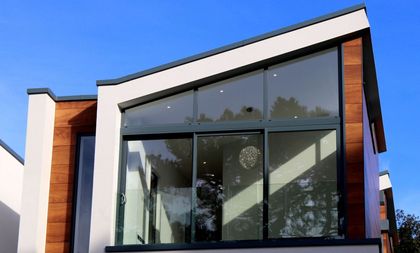Residential Window Tint: The Eco-Friendly Option for Your Home
Residential Window Tint: The Eco-Friendly Option for Your Home
Blog Article
How Residential Home Window Tinting Boosts Your Home's Energy Performance
Residential window tinting offers a compelling service for house owners seeking to improve power effectiveness within their home. By using specialized films to home windows, it successfully reduces warm transfer, therefore maintaining interior temperatures and reducing the need for excessive heating or air conditioning. This not just cuts power consumption however additionally provides a more comfortable atmosphere by alleviating glare. Understanding the nuances of how tinting works and choosing the appropriate type for your home can be critical. Oddly, what aspects should one consider before making this investment?
Recognizing Home Window Tinting
Recognizing window tinting is necessary for house owners seeking to enhance both convenience and energy efficiency in their living spaces. Residential Window Tint. Home window tinting includes the application of a thin movie to the inside or outside surface area of glass windows. This film can significantly modulate the quantity of sunshine and warmth that goes into a home, therefore affecting indoor environment problems
There are different sorts of window tinting movies available, each with distinct properties. For example, dyed movies soak up solar power, while reflective movies deflect it far from the glass surface area. Ceramic films use a balance of presence and warm being rejected, making them a prominent selection amongst homeowners. The effectiveness of window tinting is often gauged by its Visible Light Transmission (VLT) percentage, which indicates exactly how much light can pass with the movie.
Advantages of Power Performance
Window tinting not only enhances appearances but also plays a considerable duty in boosting energy performance within domestic spaces. By lowering warm transfer through windows, tinted films produce an extra stable indoor climate, which can cause substantial decreases in power usage for home heating and air conditioning. This energy efficiency translates right into reduced energy costs, supplying home owners with considerable long-term savings.

Furthermore, window tinting improves the comfort of living areas. By minimizing glow and obstructing unsafe UV rays, colored home windows develop a more enjoyable atmosphere, which can result in boosted wellness for residents. The protection against UV rays also assists preserve furnishings and flooring from fading, adding to the durability of home products.
How Tinting Works
Tinting movies run via a combination of innovative materials and modern technologies designed to control the quantity of solar power entering a home. Mainly made up of polyester, these films commonly incorporate metal or ceramic bits that show and absorb warmth. This double ability allows them to dramatically reduce the penetration of ultraviolet (UV) rays and infrared radiation while permitting noticeable light to pass through.
The performance of home window tinting is measured by its solar warm gain coefficient (SHGC), which suggests just how much solar power is transmitted with the home window. Reduced SHGC worths are better as they represent higher warmth being rejected. In addition, home window tints can include a selection of tones, permitting house owners to personalize their aesthetic preferences while boosting power efficiency.
Furthermore, these movies serve as an obstacle, avoiding heat loss throughout colder months by mirroring interior heat back right into the home. This thermal insulation result matches the cooling advantages gained throughout warmer months, adding to a balanced interior environment year-round. By taking care of solar energy effectively, domestic home window tinting not only boosts convenience but also plays an important function in reducing power consumption and lowering energy bills.
Selecting the Right Tint

There are different types of home window movies offered, consisting of colored, metalized, and ceramic. Ceramic films provide exceptional heat control without compromising visibility and are highly sturdy, making them a popular choice.
Noticeable light transmission (VLT) is another crucial factor, as it shows the amount of natural light that can go through the tinted glass. Home owners must select a color with a VLT that matches their lighting preferences while still providing sufficient glow reduction.
In addition, evaluating the solar warmth gain coefficient (SHGC) can aid establish how well a color can block warm from sunlight. A lower SHGC shows much better warmth control, eventually enhancing power performance.
Installation and Maintenance Tips
Correct installment and maintenance are crucial parts in making the most of the benefits of residential window tinting. To accomplish ideal results, it is advisable to hire a qualified specialist for installation. This guarantees that the color is used properly, staying clear of air bubbles, creases, or imbalance that can endanger performance. Specialists likewise use specialized devices and methods, which can improve the resilience and effectiveness of the tint.
Complying with installation, upkeep is necessary to lengthen the life of the window film. It is suggested to wait at least one month before cleaning up the tinted windows to enable the glue to treat completely. When cleansing, utilize a soft this page fabric and a gentle, ammonia-free cleaner to stay clear of damaging the film. Avoid rough materials that might scrape the surface area.
Attending to these concerns without delay can prevent additional damages and preserve energy efficiency. By sticking to these installment and maintenance suggestions, property owners can ensure their window tinting continues to offer significant energy cost savings and convenience for years to come.
Verdict
In conclusion, property home window tinting offers as a reliable solution for enhancing power effectiveness within homes. By lowering warmth transfer and blocking harmful UV rays, window films add to lower energy consumption and improved interior convenience.
Home window tinting involves the application of a thin film to the interior or outside surface area of glass windows. By minimizing warmth transfer with home windows, colored films develop an extra steady indoor environment, which can lead to substantial reductions in energy consumption for heating and cooling.The performance of home window tinting is measured by its solar heat gain coefficient (SHGC), which suggests just how much solar energy is transferred via the home window. By taking care of solar energy successfully, domestic window tinting not just improves comfort yet additionally plays an essential function in lowering energy intake and lowering energy bills.
By minimizing heat transfer and blocking damaging UV rays, window movies contribute to reduce my site energy consumption and boosted indoor comfort.
Report this page